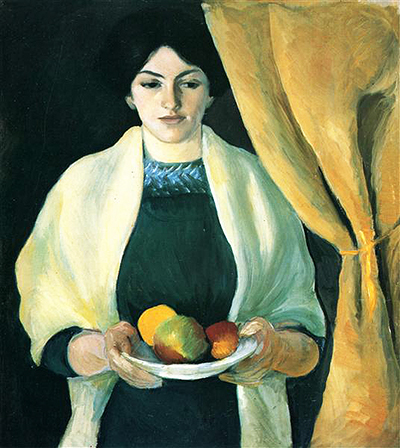Portrait with Apples was completed by German artist, August Macke, in 1909. It is one of a number of artworks in which the artist used the same model in a variety of poses.
This scene of domestic life combines figurative art with still life. The carefully planned composition features a darkened background which provides neutrality, whilst a long thick curtain drapes to the right hand side. The model, someone used regularly by Macke, holds a small bowl of apples whilst standing by the window, looking out towards the viewer. She would appear again in Woman Reading and Woman Sewing, which are both likely to have also been produced in 1909. The artist's style here is more traditional than the abstract works that followed a few years later. The forms here are easy to identify and created in much more of a realistic way than his fractal blocks of colour that occurred just before his passing in WWI.
Macke produced most of his figurative portraits outside, such as in gardens or forests, making this a relatively rare domestic scene. The techniques of depicting drapery are impressive and worthy of note here, as are the still life fruits which might remind some of the true master of this genre, namely Paul Cezanne. The apples are little too small here to really get an understanding of Macke's approach to still life painting, but it is still interesting to see him addressing such items within this piece. As mentioned earlier, he would continue his focus on domestic life with the same model in a number of other paintings during this period, but it is fair to say that he was still striving to find his own, unique artistic style at this stage in his career.
The Städtische Galerie im Lenbachhaus and Kunstbau, in Munich, Germany holds this artwork and it measures a modest 59.5cm x 66cm. That particular gallery is an excellent place to start if you are looking to learn more about German art, particularly the contributions to the Expressionist art movement. You will also discover works by Wassily Kandinsky here, such as Impression III (Concert), Improvisation 26 (Rowing) and Romantic Landscape. Botanical Theatre and Rose Garden by Paul Klee can also be found here, underlining the institution's status as being one of the most significant galleries in all of Germany.




